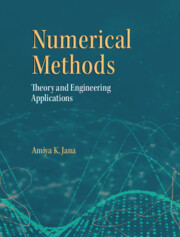Chapter 2 - Linear Algebraic Equation
Published online by Cambridge University Press: 31 December 2024
Summary
“The art of doing mathematics consists in finding that special case which contains all the germs of generality”
– David HilbertKey Learning Objectives
• Revising basics of linear systems and their different types of solutions
• Learning various solution methods (direct and indirect)
• Applying these methods to a wide variety of systems examples
• Knowing how to choose a suitable solution method
INTRODUCTION
There are several systems whose physical operations are described solely by algebraic equations. The general form of such a system of n coupled linear1 algebraic equations for n unknowns (i.e., xi, i = 1, 2, …, n) is:
Here, a11, a12,………ann, are the coefficients of the system, and 12bb,………, bn, are the constant terms.
One can represent Equation (2.1) in matrix form as:
in which, the coefficient matrix (i.e., an n × n square matrix),
unknown vector (i.e., column vector),
and constant vector,
In Equation (2.3), aij denotes an element in the ith row and jth column of matrix A. Notice that here we use capital/uppercase letters to denote the matrices and small/lowercase letters for their entries/elements.
A linear system is said to be homogeneous when it is represented by a modified form of Equation (2.2) as:
AX = 0(2.6)
Here, 0denotes a null matrix (zero vector).
At this point we should note that aside from inherently linear systems of algebraic equations, these equations arise in the systems of differential equations (e.g., boundary value problems and partial differential equations) as well. Anyway, prior to reading the subsequent sections of this chapter, the reader is recommended to go through the Appendix 2A that covers the basics of vector and matrix algebra.
Types of Solution
For linear systems of algebraic equations, mainly three types of solutions exist:
i) a unique solution
ii) infinitely many solutions
iii) no solution
Let us briefly discuss them.
To solve a system represented by,
AXB= (2.2)
instead of matrix A [Equation (2.3)], one can use the following augmented matrix (denoted by aug A) for the ease of computation:
Information
- Type
- Chapter
- Information
- Numerical MethodsTheory and Engineering Applications, pp. 27 - 133Publisher: Cambridge University PressPrint publication year: 2024
